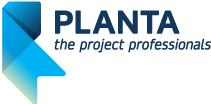Digital Project Management
Wood construction projects digitally mastered with PLANTA project
Steffen Holzbau realizes individual wood construction projects which demand a specific combination of materials and engineering competences. This includes industrial and warehouse construction, the manufacturing and assembly of wooden bridges as well as other services in the construction sector.

Steffen Holzbau plans and controls the deployment of its 120 employees simultaneously: 15–20 projects in the craft sector and 40–60 in technical project management. In order for both departments to be able to work hand in hand and to meet the high requirements, efficient resource planning is indispensable.
Due to the company’s rapid growth, increasing requirements in the planning phase, and increased demand in the wood construction sector gave rise to the company’s need for efficient software support.
The previous tools were no longer sufficient to enable transparent forecasts and planning. Due to the company’s growth, the Excel application developed in-house was furthermore not able to provide meaningful forecasts on available capacity, overloads, etc. for resource planning in the craft sector. Planning resource utilization in project management with the help of Microsoft Project also became difficult, as free capacities or resource overloads could not be mapped visually.
Objective
After a test phase in the course of which different applications were tried, a suitable project management software should be implemented to solve problems and enhance the efficiency of workflows. Challenging construction projects and closely timed work packages, which have to be coordinated with precision, determine the objectives for the introduction of the new solution, for example:
- detailed overview of the utilization of all project resources and early identification of available capacities and bottlenecks
- more precise command controlling and better scheduling for planning and implementation phase
- targeted resource planning based on individual skills
- provision of relevant key figures for post-calculation, as a basis for follow-up projects and for checking calculation data and estimates (in terms of time)
Solution Approach and Introduction
A prospective graduate was charged with the implementation of a suitable tool as part of his Master’s thesis. The decision for and implementation of the new software system was carried out in several phases. A competence team was involved, consisting of a project manager, a controller, an IT specialist, and three project team members. The decision was made in favor of PLANTA project. The sector-independent project management software of the Karlsruhe-based software company is now implemented in Potaschberg, Luxembourg, the head quarters of Steffen Holzbau.
The software system could be completely adapted to the company-specific requirements. It was, e.g., possible to integrate the time recording system. In the long term, a further integration into the ERP system is planned.
Two Areas of Application
PLANTA project is used in the technical project processing in the craft sector by the employees in project management/back office as well as by the department managers and team leaders. The software allows two multi-project managers, four department managers, and six team leaders to get an overview of the utilization and capacities of the planned resources. The new software allows the planning of the effort for the 120 employees which are planned in projects simultaneously to be accomplished by two employees. There are two other employees who are on stand-by and can provide assistance whenever needed.
There are no significant differences between the projects in the two departments. The personnel resources in the technical project management take care of planning and coordination, which includes, a.o., the creation of joinery and assembly plans, static calculation, as well as material orders. They realize the projects on paper and forward them to the construction management on site. They not only coordinate the activities of the craft sector, but also the collaboration with subcontractors and other local trades.
The craft sector is responsible for on-site assembly and prefabrication as well as production. There is a continuous collaboration between both departments.
The employees in charge with planning base their resource planning in PLANTA project on time specifications which they retrieve from calculation data and assign them to projects, departments, and individual resources. The result is a comprehensive overview of the overall utilization as well as of the load at single project and resource level.
The new project management software is now used for all construction projects. The connection and integration of in-house software has also been successful. Steffen Holzbau can now tackle to all challenges with their new project management system.

Using PLANTA since 2023


